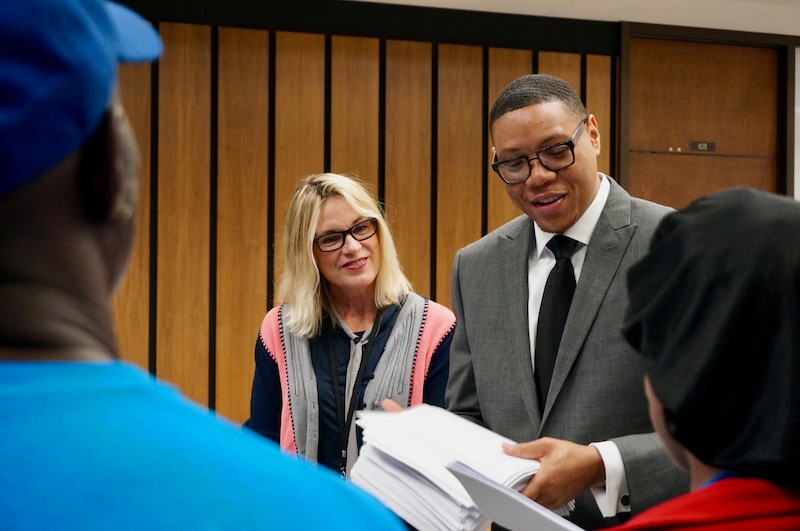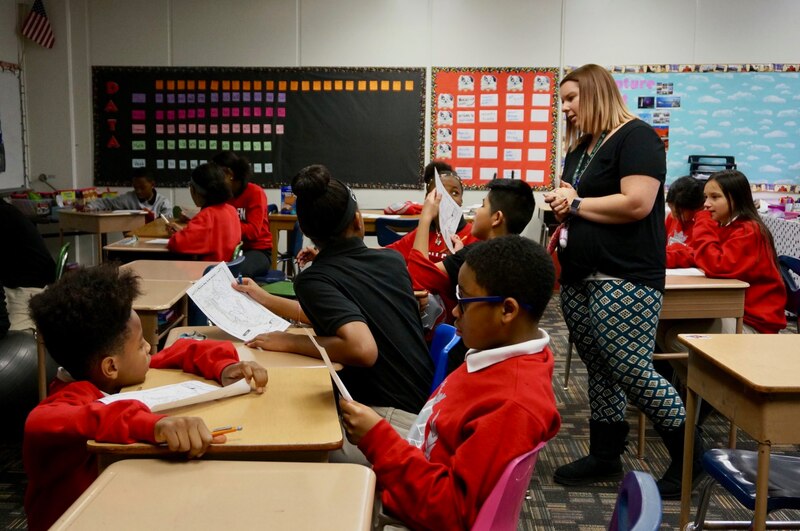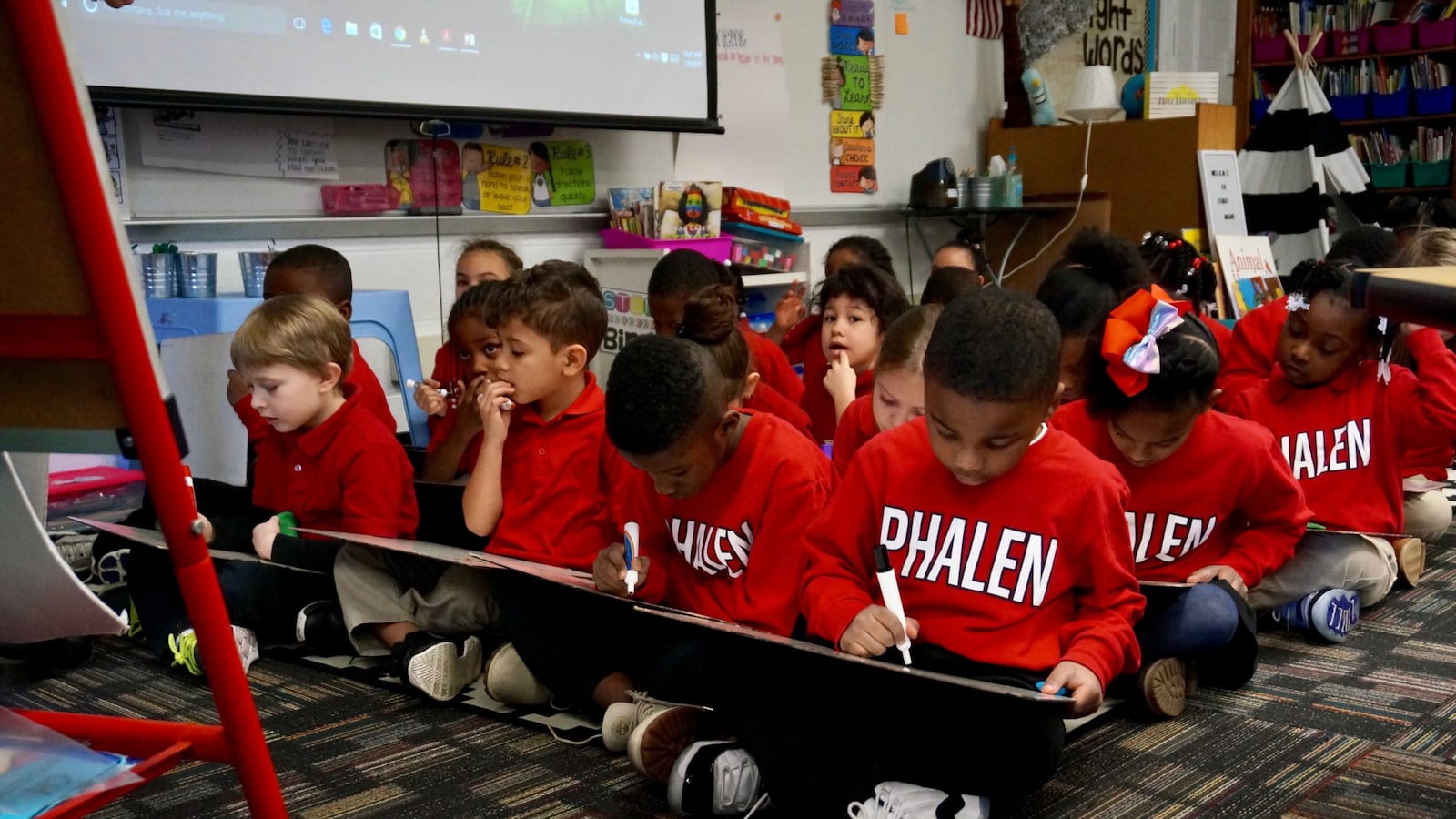Five years ago, a young superintendent months into his first job running a school district walked into the Indiana Statehouse to ask for an unprecedented change.
Lewis Ferebee felt Indianapolis Public Schools should run more like its steepest competitors: charter schools. In some cases, he thought district schools should actually be charter schools, with their own school boards outside of the district’s purview. And he wanted to partner with existing charter schools that had wooed students away from the long-struggling public school district.
“Why do we have to follow the same curriculum, why do we have to do one size fits all, all the same way?” Ferebee said while asking lawmakers to approve the novel arrangements.
It was a radical — and controversial — strategy for turning around one of Indiana’s most troubled school districts. Skeptics criticized the plan, known as innovation schools, as a further dismantling of public education that would destabilize school communities and strip union protections from teachers. But the proposal solved several pressing political problems by allaying the threat of state takeover and forging a peace with local leaders eager for major change within the struggling district.
And just five years later, the plan has undoubtedly transformed the state’s largest district: Nearly a third of Indianapolis Public Schools are innovation schools, and one in four district students now attends one of them. The highly publicized undertaking has vaulted Ferebee to national prominence, shaping Indianapolis into one of the most interesting cities in education and likely contributing to his nomination late last year to become public schools chancellor in Washington, D.C.
But while innovation school supporters have painted a rosy turnaround narrative, Ferebee is leaving before some of the most telling results bear out — a reality that could come up during his confirmation in D.C.
Test scores show students at some innovation schools are making bigger gains than students elsewhere, an outcome that’s bolstered by a recent national study. But a three-year grace period when schools may be graded based on student improvement, not overall test scores, has masked the fact that some of the schools still have among the lowest results in the district. This year, the first innovation schools will get a truer measure of their performance.
While many local leaders, state lawmakers, and education reform advocates have so far lauded the changes under Ferebee, the tide could also be turning. Critics of his administration have formed more organized opposition, helping two people skeptical of innovation schools win seats on the school board that will choose the next superintendent — who, like Ferebee, will play a key role in determining the future of the district.
The hardest question remains to be answered: Will innovation schools bring long-term positive changes for Indianapolis students?
Ending the war
In 2013, Ferebee arrived in Indianapolis to a district in turmoil.
His predecessor, Eugene White, had been at odds with the school board. Four chronically failing district schools had been taken over by the state. Indianapolis Public Schools was losing thousands of students — and state funding that followed them — to neighboring districts, charter schools, and private schools through vouchers.
Indianapolis Public Schools, serving about 30,000 students who are mostly black or Hispanic and mostly from low-income families, had some of the lowest graduation rates out of all public school districts in the state.
Outsiders’ attempts to intervene only seemed to feed an adversarial tension.
“We’ve been at war with IPS for 40 years,” former Mayor Greg Ballard recalled saying to his staff at the time. “How’s that working for us?”
But change was brewing. The Mind Trust, an influential education group that supports charter schools, had intrigued some school board members with an explosive plan that would become the blueprint for innovation schools, proposing to rethink the “broken” Indianapolis Public Schools system.
A new leader was the key to making that work.
In nearly every way, then-39-year-old Ferebee cut a contrast to his predecessor, from his modern suits to his embrace of charter schools. Tall and calm, with thick-rimmed glasses that matched his academic way of speaking, Ferebee quickly won over the board and local leaders.
What local leaders said distinguished him the most, though, was his willingness to collaborate with the mayor’s office and The Mind Trust on “innovation network schools” — the charter partnerships that Ferebee said would give schools more freedom and flexibility.
“I think the fact that Dr. Ferebee is a quiet leader — and is not a flamethrower, and is not a hard-charging reformer — meant that he was able to build coalitions that would have probably been hard for someone else to build,” said The Mind Trust CEO Brandon Brown.

Ferebee declined to be interviewed for this story. In the past, when he has been asked about why he supported the idea of innovation schools, he has talked about how having more freedom helped him improve schools when he was a principal in North Carolina.
“A lot of people associated choice and competition with unfriendly interactions,” Ferebee told the Indianapolis Business Journal in 2014. “And I don’t necessarily buy into that way of thinking. Because ultimately, when you do that, then it just creates an opportunity for students to fall through the cracks.”
By championing innovation schools, Ferebee invited criticism from those who saw the approach as “giving away” traditional public schools to charter operators.
Teachers at innovation schools cannot join the district teachers union, and the strategy might not have progressed so quickly if the union had been more powerful. But the Indianapolis Education Association, weakened by state law and internal dysfunction, did not mount a vigorous opposition. And as the schools expanded, fewer and fewer teachers were covered by the district contract.
“It’s a way of putting a different face on charters,” said Susan Collins, a newly elected Indianapolis Public Schools board member who is critical of innovation schools. “We have sold off a particular population of students to benefit a charter.”
But the city’s biggest education reformers, who were pushing for innovation schools, say Ferebee’s support was a critical bridge between ideological divides.
“He put a lot of his personal and professional capital on the line,” said state House education leader Bob Behning, an Indianapolis Republican. “Because Ferebee was willing to do it, I think people saw this as something we should at least consider and look at.”
Fast changes
After receiving special permission from the state, Indianapolis Public Schools moved quickly to begin creating innovation schools in 2015 with the backing of a new slate of reform-friendly board members. The district brought in Phalen Leadership Academies, which ran an Indianapolis charter school, to overhaul School 103, a chronically failing neighborhood school on the far eastside. Phalen took dramatic action, hiring a new principal, replacing teachers, and bringing in a new model that relied on computers.
“What we’re doing won’t be easy,” charter leader Earl Phalen said shortly after the school opened. “But as long as you have every adult in the building buying into it, it can be done.”
The innovation network has grown to 20 schools in the four years since then. Despite the name, most innovation schools are a lot like other charter or magnet schools. Supporters of the approach say the truly innovative element is the partnership between the district and outside managers.
In some cases, Indianapolis Public Schools uses innovation partnerships to overhaul struggling schools such as School 103. But successful district schools and independent charter schools have also signed on. Traditional public schools gain autonomy, and charter schools can tap into the district’s transportation or food services, gain access to buildings, and receive more funding from the district.
The Mind Trust plays a role by identifying and coaching leaders for innovation schools, with many candidates receiving a fellowship to develop their plans. The mayor’s office oversees the innovation schools that also have charters.
Innovation schools differ greatly from district schools in some ways. Their operators have control over daily management, and they are free to make choices such as teaching a STEM-focused curriculum or extending school days. The schools operate outside of the teachers union contract, a sticking point for some of their critics.
Indianapolis Public Schools can benefit from the relationship by getting to count innovation schools’ enrollment, test scores, graduation rates, and school grades toward district-wide metrics. So far, they’re largely making the district look better, at least on paper.
Contracts typically outline expectations for innovation schools, which supporters say allow the district to sever the partnership if needed. Still, low-performing innovation schools have not yet faced serious consequences. And critics say the cash-strapped district has paid the new managers too much money.
One of Ferebee’s biggest wins is that charter competitors have joined the innovation network, including the high-achieving Herron High School and the local KIPP network. Innovation has also brought new models under the district’s wing, like the dual-language program at Global Prep Academy and the widely heralded Purdue Polytechnic High School, an unconventional approach to high school that structures learning around projects.
The innovation network has also given new freedoms to promising district schools, like School 93, which uses an approach created by teachers called Project Restore, built on the core tenets of frequent tests, regular rewards, and consistent discipline.
Even before its conversion to innovation, students at School 93 were making large gains on state tests. And the school’s success had won the leaders lots of flexibility from the district.
But Principal Nicole Fama sought more independence. Now that it’s an innovation school, School 93’s teachers are not employed by the district and not under the union contract. That allows Fama to require teachers to stay after school for tutoring and go to evening events with families.
Becoming an innovation school also gave Fama more certainty. Instead of relying on the next superintendent to support the school’s philosophy, the manager now has an innovation contract through June 2021 clearly outlining its independence.
“We were given the freedom to be trusted 100 percent for the first time,” Fama said. “Because all the other times, even though we were turning schools around, we still always kind of had to operate around certain district parameters.”

Uncertain results
Four years into the experiment, there is not yet definitive evidence of whether innovation schools have benefitted student learning overall — and it seems increasingly likely that the results will vary by school, with some showing successful outcomes and others floundering.
Passing rates on state tests have jumped at some innovation schools, and supporters are optimistic the schools will see even more improvement once leaders have had time to lay groundwork by tackling issues such as student discipline and parent engagement. One of the earliest successes was at Global Prep Academy at School 44, where proficiency scores more than doubled the first year. This year, School 93 and Emma Donnan Elementary School had some of the highest scores in the district for student improvement on the state test.
A recently released study found that students at innovation schools improved about as much on tests as the state average, better than district schools did, but the results were not statistically significant.
Some overhauled innovation schools, which serve neighborhood students, still have some of the lowest passing rates in the district. Three innovation schools had such low scores and improvement in 2018 that Ferebee’s administration placed them on a list of low-performing schools eligible for district review. They include two schools where fewer than 10 percent of children passed state tests: Kindezi Academy at School 69 and Ignite Achievement Academy at School 42. The district is not expected to restart any additional schools with innovation partners next school year.
Overall, the district improved in some areas during Ferebee’s tenure, particularly rising graduation rates. But the district remains deeply troubled. After three years of declines, less than a quarter of elementary and middle school students passed both the math and English state tests last year. Black and Hispanic students have significantly lower passing rates than their white peers, and the gap grew wider between 2015 and 2018. While the district improved to an overall D rating from the state, just over half of its schools still have Ds or Fs, slightly fewer than before Ferebee’s arrival.
Despite those enduring problems and the uncertain results from innovation schools, the strategy has already helped the maligned district escape further state intervention — or takeover — and craft a new image as a growing and changing school system.
When innovation schools are new, their results routinely look better on paper. Eight schools had improvement in grades when they became innovation, including schools where passing rates on state tests stagnated or dropped. That’s because schools that join the innovation network can choose for their state grades to be based on a scale that focuses on how much student test scores improve, which typically leads to better grades. But the law only allows schools to be graded that way for three years.
This year will be the first time that a school that was overhauled with a charter partner is graded based on the same standards as other traditional public schools, which are typically more difficult.
Innovation schools have also appeared to help turn around a long-running decline in enrollment in IPS. When Ferebee arrived in 2013, the district enrolled nearly 31,000 students, and in the years since, it has grown by about 700, an accomplishment often cited by his supporters. But dig into the numbers, and it’s clear that enrollment in district-managed schools has continued to slowly shrink, and it is only by adding charter schools to the network that Indianapolis Public Schools has been able to grow.
As innovation schools mature, district leaders will increasingly face the question of how to measure their success and what to do at schools where passing rates on state tests are not improving.
It’s an issue interim Superintendent Aleesia Johnson is grappling with. Some of the first schools that joined the innovation network will be up for contract renewals in 2020, and district officials are working on a framework for assessing those partnerships, Johnson said. Because the final decision depends on what the school board prioritizes, she said she couldn’t give specifics.
Ferebee’s embrace of partnerships with charter schools has helped establish him as a national education leader with particular cachet among advocates for such collaboration — a reputation that was likely one reason he was tapped to the lead the Washington, D.C., school system.
The most significant scandal during Ferebee’s time in Indianapolis came when school officials failed to properly report to the department of child services a sexual relationship between a student and counselor. His handling of that incident is already beginning to draw scrutiny in the capital. But his friendliness to charter schools is also sure to generate controversy. The day Ferebee’s nomination to run Washington, D.C., was announced, he said he did not intend to follow the same approach of collaborating with charter schools.
“It is not my intent to transport strategies from Indianapolis as a panacea for moving us into our next phase of excellence,” he said. “I don’t come to the table assuming that I have all the answers.”
Rising opposition
Despite broad support for innovation schools from the school board, Ferebee faced persistent criticism that he did not do enough to engage the community. Some of the decisions to convert schools were met with outcry from families and educators who were taken by surprise.
It’s a common problem in attempts at education reform in poor communities and communities of color: a feeling that change, even experimentation, is out of their hands and being done unto them, rather than being driven by them.
Local civil rights and community advocate Marshawn Wolley acknowledged that it was important for Indianapolis Public Schools to be open to trying something new. But Wolley said the district hasn’t done enough to engage with families and civic organizations, particularly those representing children of color.
“I don’t think that really the community fully understood what was happening, and I think we’re still trying to figure out the implications,” Wolley said.
Some of the district’s most struggling schools have had dramatic makeovers, removing just about every educator as a new leader attempts a fresh start. But that can cause upheaval for students, observers say.
“It just creates a lot more instability in already unstable home lives,” said Charity Scott, a former teacher who is now executive director of the IPS Community Coalition, a group critical of Ferebee’s administration.
Advocates say compared to other cities, the discord is muted, which allowed the district to transform as quickly as it has. But spurred by discontent over the closing of three high schools unrelated to innovation, concerns over the district’s current trajectory are gaining momentum.
Last fall, two candidates unseated incumbents on the school board who supported Ferebee. New board members Collins and Taria Slack are skeptical of the rapid growth of innovation schools.
For now, most of the board members still seem interested in continuing to expand innovation schools. When Ferebee announced his departure, the board quickly moved to appoint Johnson, who has led the district’s innovation efforts, as the interim leader.
And although Ferebee is gone, the other players who were instrumental in creating a school system where charter and traditional public schools partner are still influential in Indianapolis.
“There are a lot of people working together to make the kinds of changes that have happened over the last five years,” said Caitlin Hannon, who was on the school board when Ferebee was hired and now leads the city’s shared enrollment system for district and charter schools.
Even if Ferebee’s departure alters the speed of transformation, she said, “there are enough people left in Indy who are interested in moving in that direction that it will endure.”

